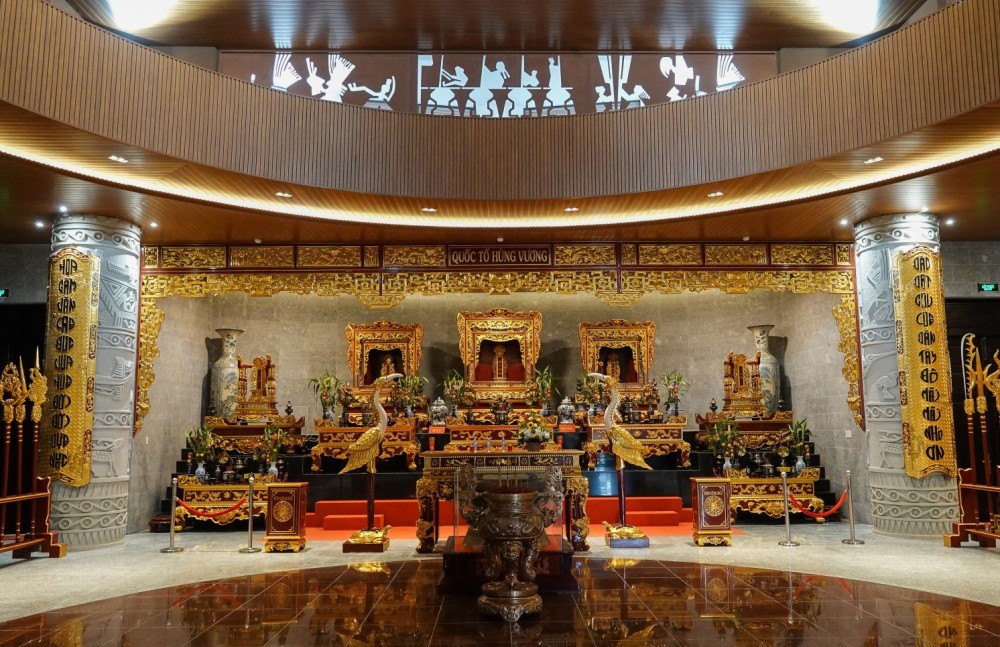The history of the Vietnamese nation spans over thousands of years. It traces its origins to Lac Long Quan, known as the Dragon Lord of Lac, who is revered as the father of all Vietnamese people. Lac Long Quan’s partner, the fairy goddess Au Co, is regarded as the Mother. Their offspring, King Hung, established Van Lang, which stands as the First Nation in Vietnamese history. For 18 generations, the Hung kings held rule over Vietnam and are honored through a complex of temples dedicated to their worship.
Vietnamese people ceremoniously celebrate the commemoration day of the Hung Kings, revered as the legendary founders of the nation. This annual tradition takes place on the 10th day of the third lunar month. It is worth noting that the Hung King worshiping ritual holds UNESCO recognition as an intangible cultural heritage of humanity.
 |
| Hung King Temple in Can Tho city. Photo: Thanh Nien Online |
In Can Tho City, the Hung King Temple, spanning nearly 4 hectares and with a total budget of VND 129.5 billion, was inaugurated and made accessible for public visit on April 6th.
 |
| Photo: Bao Can Tho |
The temple boasts several prominent features, including the main temple, main gate, stele house, ritual house, executive house, and courtyard.
The primary temple is encircled by a square lake, exemplifying the traditional concept of “round heaven and square earth.”
There are 18 bows encircling the lakes, symbolizing the 18 Hung Kings. Each bow is extravagantly adorned, emulating motifs found on Dong Son bronze drums.
 |
| Inside the lake, there are 54 stone pillars representing the community of 54 ethnic groups. Photo: Bao Can Tho |
In the lake, you will find 54 stone pillars symbolizing the unity of the 54 ethnic groups and showcasing the distinctive cultural essence of the Mekong Delta.
 |
| Worshiping space in the Main Temple. Photo: Bao Can Tho |
Upon entering, the central area of the worship space is dedicated to the veneration of Quoc To Hung Vuong, while the two adjacent sides are designated for the worship of Father Lac Long Quan and Mother Au Co.
The worship space also exhibits ceremonial items such as ancient weapons, bronze drums, bells, halberds, etc. These artifacts have been graciously contributed by the People’s Committee of Phu Tho province.
 |
| Big mural on both sides of the worshipping space tells the legend of Vietnam’s origin. Photo: Bao Can Tho |
According to the myth of Vietnam’s creation, Lac Long Quan and Au Co produced a bag containing 100 eggs that hatched into 100 children. Despite their love for one another, The Mother harbored a longing to return to the mountains and Lac Long Quan yearned for the sea, where time is measured by seasons.
After their separation, Âu Cơ and Lạc Long Quân each took fifty children under their care. Âu Cơ chose to settle in the snow-covered mountains of Vietnam, where she raised fifty outstanding young leaders. These individuals were later referred to as the Hung Vuong or Hung Kings. Among her sons, the most prominent one became the first Hùng king, who went on to rule Van Lang.
According to the legend of the Chung cake and Day cake, during the reign of the 6th generation of the Hung King, there was a competition held to determine his successor. Instead of following the traditional practice of passing the throne to his eldest son, the King decided to choose his successor based on the quality of their offering for ancestral worship. Surprisingly, it was the youngest son, Lang Lieuu, who emerged victorious by presenting a white round cake made of sticky rice called Day, symbolizing the Heaven, and a green square cake called Chung, representing the Earth. This triumph led to Lang Lieuu becoming the 7th Hung King.
The Origins of the Vietnamese People
The Vietnamese people trace their heritage back to the mythical figures of Dragon and Fairy Âu Cơ. According to legend, Dragon and Fairy Âu Cơ had many descendants who eventually formed the Vietnamese nation. This rich and ancient history is an integral part of Vietnamese culture and identity.
 |
| The Main Gate. Photo: Bao Can Tho |
On the evening of April 6, President Nguyen Xuan Phuc and the Standing Vice Chairman of the National Assembly Tran Thanh Man were warmly welcomed by Can Tho City People’s Committee at the inauguration ceremony of the Hung King Temple. The temple is located in area 7, Binh Thuy Ward, Binh Thuy District.
 |
| After the inauguration ceremony, the temple will officially open to welcome visitors from April 7. Photo: Dan Toc va Phat Trien |
Youth long to promote nation’s history
NDO—After three years, 10,000 copies of Ngan nam ao mu (A Thousand Years of Caps and Robes) by Tran Quang Duc have been sold—an impressive number for a history book. His friend, Nguyen Huu Su, is preparing to publish his book Lich su thu phap (History of Calligraphy). They are working on things they believe in.








